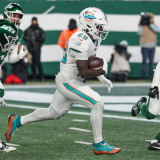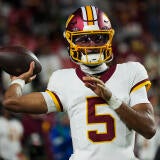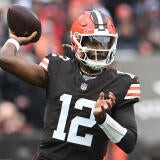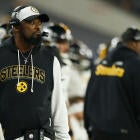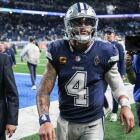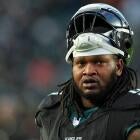Agent's Take: Making sense of all the money talk following the NFL Draft
Now that the NFL Draft is over, let's turn our attention to money, money, money.

The 2016 draft class will start getting its first taste of NFL action this weekend. Teams can hold their one three-day rookie minicamp during the first two weekends after the NFL Draft. Some draft picks will already be under contract when the minicamps start.
The Minnesota Vikings got the ball rolling by signing sixth-round pick Moritz Boehringer of Germany, the first player ever drafted directly from a European league, to a four-year, $2,490,240 contract with a $150,420 signing bonus. A primary reason for getting Boehringer’s contract done so quickly is he must have proof of employment to obtain a work visa.
Keanu Neal is the first player taken in the first round to sign a contract. The Atlanta Falcons gave the 17th-overall pick a fully guaranteed four-year, $10,737,646 contract. The draft picks who don’t sign deals prior to minicamp will participate under agreements which will still pay them like their draft slot if any type of injury is sustained. Dante Fowler, Jr. received the same contract he would have gotten if healthy from the Jacksonville Jaguars last year as the third overall pick when he tore the ACL in his left knee during the first practice of minicamp. Rarely does a draft pick refuse to participate in the rookie minicamp because his deal hasn’t been completed.
Here are seven financially related thoughts and observations relating to the draft.
1. Ezekiel Elliott is already being paid like a Top-10 running back

The rookie wage scale implemented by the current Collective Bargaining Agreement in 2011 is designed to prevent top draft picks from being paid like highly productive veterans as unproven commodities. Ezekiel Elliott, the fourth overall pick by the Dallas Cowboys, may be the one exception because of the economic downturn with running back salaries.
The Ohio State product is expected to sign a fully guaranteed four-year, $24,956,338 contract, which includes a $16,350,064 signing bonus. Elliott’s $6,239,085 average yearly salary makes him the NFL’s ninth highest paid running back by this metric. His expected contract is slightly more than the reported best offer the Cowboys gave DeMarco Murray in 2015 as a free agent. Dallas was unwilling to pay Murray more than $24 million over four years with $12 million fully guaranteed after a 2014 season in which he lead the league in rushing by gaining 1,845 yards on the ground on 392 carries, the eighth-most ever in an NFL regular season.
This dynamic with the running back market didn’t exist in 2012 when the Cleveland Browns selected Trent Richardson with the third-overall pick. Richardson’s fully guaranteed four-year, $20,489,796 contract made him the NFL’s 16th-highest paid running back by average yearly salary. There were ten running backs signed to veteran contracts averaging over $7 million per year in 2012. Only five running backs currently top the $7 million per year mark.
Teams have a fifth-year option with first-round picks that must be exercised after the third year of a rookie contract. The decision on the option year wouldn’t need to be made until 2019 in Elliott’s case. As a top-10 pick, Elliott has the worst value for a fifth-year option relative to the salary structure at the various positions. His option-year salary, which will be the same as the running back transition tag, should be north of $10 million. This year’s running back transition tag is $9.647 million.
Adrian Peterson, whose contract expires after the 2017 season, is the only running back with a deal averaging more than $10 million per year. There may not be any when the decision needs to be made on Elliott’s option unless Le'Veon Bell is able to break the barrier on his next contract.
Elliott should be a leading candidate to be the NFL’s Offensive Rookie of the Year running behind arguably the game’s best offensive line as Dallas tries to replicate the success it had with Murray in 2014. If Elliott is successful, the chances that he plays under his option salary or signs an extremely lucrative second contract may be compromised because of his high mileage at a position that has a relatively short shelf life.
2. What Paxton Lynch means to Von Miller's bottom line
Denver Broncos franchise player Von Miller expressed optimism last week that he could be signing a new contract any day. General manager and executive vice president of football operations John Elway trading up five spots to the 26th pick to select quarterback Paxton Lynch could help the Super Bowl 50 MVP in his quest to become the NFL’s highest-paid non-quarterback. The distinction is currently held by defensive tackle Ndamukong Suh, who received a six-year, $114.375 million contract containing $59.955 million fully guaranteed from the Miami Dolphins last year as an unrestricted free agent.
Miller doesn’t have to contend with the prospect of the Broncos having a high-priced quarterback on the books. Once Lynch takes over at quarterback, he will be one of the NFL’s lowest-paid starters at the position. He is expected to sign a four-year, $9,496,307 contract where his largest salary cap number in 2019 will be slightly more than $3 million. If Lynch is the long-term solution at quarterback, he won’t be able to sign a contract extension until 2019 when the guaranteed money under any long-term deal Miller signs this year will have run out.
3. Just how much money is Tunsil set to lose on his rookie deal
A video of Ole Miss tackle Laremy Tunsil smoking out of a bong with a gas mask being leaked from his hacked Twitter account minutes before the start of the draft was costly. The Baltimore Ravens passed on Tunsil with the sixth-overall pick because of the video. He was taken by the Miami Dolphins with the 13th pick. Ronnie Stanley, who the Ravens selected, is expected to sign a fully guaranteed four-year, $20,484,433 deal. Tunsil’s fully guaranteed four-year contract should be worth $12,457,648. There’s a $7,996,785 difference in the two deals. The discrepancy is even greater when the value of fifth-year options is considered. Top-10 picks get the transition tender (average of the ten highest salaries) for a player’s position in the fourth year of his contract. With players selected outside of the top ten (picks 11-32), the fifth-year salary is the average of the third through twenty-fifth highest salaries at a player’s position. The two offensive line option-year salaries are currently $11.902 million and $8.821 million.
4. RG3's rebirth opportunity in Cleveland
Robert Griffin III signed a two-year, $15 million deal (worth up to $22 million with incentives) with the Cleveland Browns because it was his best chance to resurrect his career. When the Browns traded out of the No. 2 spot in the draft, there was speculation that a quarterback could still be taken with the eighth pick. The Browns traded down to 15 during the draft and used the pick on wide receiver Corey Coleman.
Griffin should be encouraged because USC quarterback Cody Kessler wasn’t taken until late in the third round. The 2012 NFL Offensive Rookie of the Year may not get another shot at being a starting quarterback if he can’t beat out 36-year-old journeyman Josh McCown, Kessler, who is widely considered as a reach in the third round, and Austin Davis.
5. Will money spent equal success in Jacksonville?

Jaguars owner Shad Khan raised the bar prior to free agency by stating he expects a winning record this season. Jacksonville’s draft is getting rave reviews from most NFL pundits, including our Pete Prisco.
Fifth-overall pick Jalen Ramsey has been compared favorably to All-Pro cornerback Patrick Peterson. Second-round pick Myles Jack is a top ten talent. The linebacker slipped in the draft because of concerns over his right knee. Last year's first-round pick, Dante Fowler, Jr., will be making his NFL debut after undergoing reconstructive knee surgery last spring. Jacksonville also made a splash in free agency by signing defensive lineman Malik Jackson to a six-year, $85.5 million contract (worth a maximum of $90 million through salary escalators) containing $42 million in guarantees.
With the Jaguars fixing a porous defense, which allowed the second most points in franchise history in 2015 (448), general manager David Caldwell and head coach Gus Bradley may not get another season without coming close to or meeting Khan’s expectations.
6. San Francisco’s marriage of convenience
Colin Kaepernick and the 49ers seemed to be headed for a divorce as his agents were given permission by the team to seek a trade. The Broncos were the most viable option. Trade talks stalled because Kaepernick was unwilling to cut his $14.3 million 2016 salary, of which $11.9 million is fully guaranteed, to $7 million for the Broncos.
Denver is now out of the picture after drafting Lynch with the 26th pick. San Francisco didn’t address quarterback until late in the sixth round when Jeff Driskel was taken. Since there isn’t obvious trade partner, Kaepernick should be under center for the 49ers this season provided he can beat out Blaine Gabbert.
7. Eugene Monroe’s roster security
The Baltimore Ravens using the sixth-overall pick on Ronnie Stanley immediately prompted speculation that Eugene Monroe’s days with the team were numbered. Although the Ravens’ public stance is the two players will compete for the left tackle job, teams I’ve spoken to aren’t convinced Monroe will remain in Baltimore. He is scheduled to make $6.5 million this year on an $8.7 million salary cap number.
If the Ravens wait until June 2 to cut him, $6.5 million of cap room would be picked up. There would also be a $4.4 million cap charge in 2017 because of the $11 million signing bonus he received when he signed a five-year, $37.5 million deal in 2014. The Chicago Bears, New York Giants and Seattle Seahawks could have interest if the Ravens part ways with Monroe.
Joel Corry is a former sports agent who helped found Premier Sports & Entertainment, a sports management firm that represents professional athletes and coaches. Before his tenure at Premier, Joel worked for Management Plus Enterprises, which represented Shaquille O'Neal, Hakeem Olajuwon and Ronnie Lott.
You can follow him on Twitter: @corryjoel | You can email him at jccorry@gmail.com

